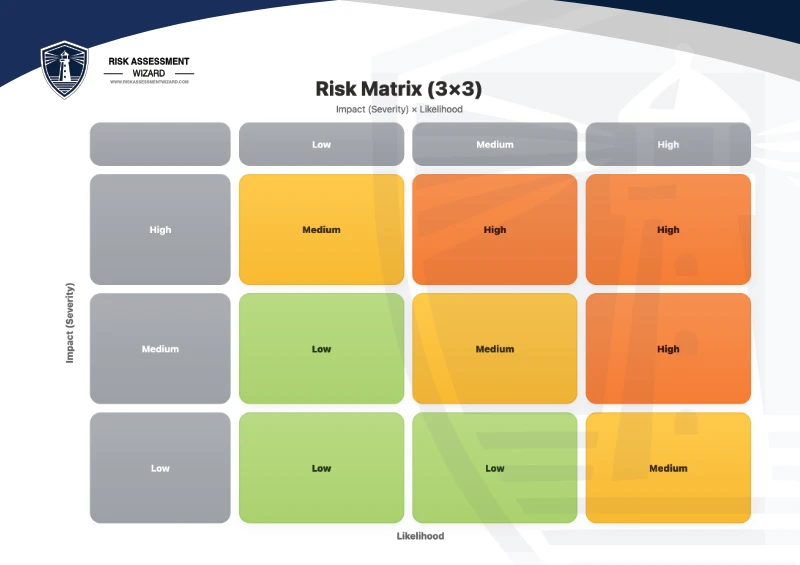Free Risk Assessment Template (PDF)
Use our standard blank template right away, or jump into the online generator to export a tidy, branded PDF. You can try the generator without an account; you’ll need a free account to save and edit at a later date.
Tip: Most PDF viewers have their own print button if you want paper copies.
Quick index
Blank risk assessment template
This is the same blank PDF you already publish elsewhere on the site. Download it or open it full-screen. For branding (logo, org name) and tidy sectioning, use the online generator.
Example templates by activity
Pick a starting point, then make it yours. These examples pull typical hazards from your library and open straight in the wizard.
 Animal Care
Animal Care
Typical hazards: Animal bites, Animal scratches, Zoonotic disease transmission, Exposure to anesthetic gases.
 Construction & Trade
Construction & Trade
Typical hazards: Exposure to hazardous substances, Fire and explosion risks, Gas leaks, Inadequate ventilation.
 Event Planning
Event Planning
Typical hazards: Inclement weather, Vendor cancellations, Technical equipment failure, Guest injuries.
 Financial Services
Financial Services
Typical hazards: Unauthorized access to sensitive data, Regulatory non-compliance, Credit defaults, Market volatility.
 Food & Beverage
Food & Beverage
Typical hazards: Slippery floors and walkways, Hot surfaces and steam, Hot oil and frying operations, Knife handling and sharp tools.
 Forest Schools
Forest Schools
Typical hazards: Incorrect sitting position while using tools, Tools left unsupervised, Using tools without understanding safety rules, Distraction or lack of focus during tool use.
 Hair & Beauty
Hair & Beauty
Typical hazards: Allergic sensitisation to hair dye, Irritant dermatitis at test site, Cross-contamination during application, Test frequency and timing.
 Landscaping, Gardening & Tree Work
Landscaping, Gardening & Tree Work
Typical hazards: Rotating blades (walk-behind/hover), Ejected debris/projectiles, Slopes and unstable ground, Ride-on mower rollover.
 Office & Professional Services
Office & Professional Services
Typical hazards: Display screen equipment (DSE) use, Slips, trips and falls in walkways, Stairs and ramps, Manual handling of office items.
 Outdoor Activity Provider
Outdoor Activity Provider
Typical hazards: Drowning, Capsizing, Cold water, Heatstroke and sunburn.
 Place of Worship
Place of Worship
Typical hazards: Crowd movement and congestion, Fire risk in building, Candles and open flames, Slips and trips in public areas.
 School & Education
School & Education
Typical hazards: Weather exposure and preparedness, Food safety and allergies, Behaviour and group management, Interaction with the public and safeguarding.
 Scouting & Guiding
Scouting & Guiding
Typical hazards: Open flames and cooking equipment, Gas cylinders and fuel storage, Carbon monoxide in enclosed spaces, Food hygiene and catering.
 Sports & Recreation
Sports & Recreation
Typical hazards: Collision between players, Slippery playing surfaces, Dehydration and heat exhaustion, Muscle strains and sprains.
 Youth Group
Youth Group
Typical hazards: Slips, trips, and falls, Insect bites, Heat exhaustion, Cold exposure.
One-page risk matrix
Use this quick matrix to score identify the level of risk before and after controls. This will differ by organization — adjust to your policy.
Risk thresholds (example)
- Low: Acceptable with routine controls; keep an eye on it.
- Medium : Improve controls and monitor.
- High: Do not proceed until risks are reduced.
How to use this template
- Describe the activity: People involved, place, date/time, contacts.
- List the benefits: Why the activity is worth doing.
- Identify hazards & who could be harmed: Be specific and practical.
- Set measures: Controls people will actually follow; assign a responsible person.
- Score risk: Record before and after controls using the matrix.
- Review & sign-off: Add notes, approval, and a review date.
What your PDF includes (in the online generator)
- Overview (activity, people, contacts)
- Benefits, hazards, and measures
- Risk levels before and after controls
- Responsibilities, notes, review line
- Your organisation name and logo
FAQs
Will I get a real PDF?
Yes — the blank template here is a real PDF you can download. For a tidy, branded PDF from the online generator, create a free account.
Do I need an account?
No. You can use the online generator without an account.
Is this legal advice?
No. You’re responsible for the completeness and accuracy of your assessment. Follow local regulations and professional guidance as required.
Can teams collaborate?
Yes - on paid plans teammates can view, download, edit, and duplicate assessments to keep documents consistent.
Get started
Use the blank PDF now or jump into the online generator for a polished PDF with your logo.


